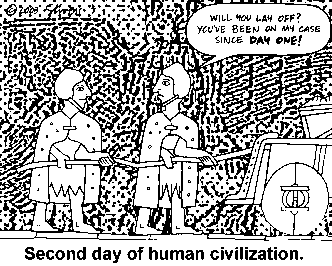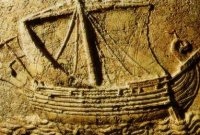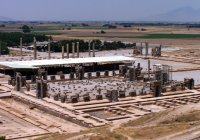COURSE OUTLINE
| Instructor: |
Dr.
Ewa Wasilewska |
| Office
hours: |
By
appointment only; please call the Department of Anthropology (581-6251)
and leave your name, phone number, and class number. |
| Time: |
Each
Wednesday at 6:00 p.m. to 9:00 p.m. |
| Location: |
CAMPUS
- ST 208 |
| Important
dates: |
September
2, 05 - last day to drop classes
September
6, 05 - last day to add classes
September
6, 05 - last day to elect CR/NC option or to audit classes
October
21, 05 - last day to withdraw from term length classes |
| Required
Texts: |
All
required articles/chapters (in chronological order) are to be found at
the Reserve Desk at Marriott Library. Please check also electronic reserve
by Marriott Library.
All
articles/chapters are listed below as the required reading for specific
weeks.
Since
it might be cheaper and faster to order Stiebing’s book than to copy it,
this book (Stiebing, William H. Jr. Uncovering the Past: A History
of Archaeology. Pp. 55-248. Oxford University Press. 1993) has
been ordered through the University Bookstore. This book is a lot of fun!
Ewa
Wasilewska: Rise of Civilization. Notes. 2005. (EW)
Notes
can be purchased during the first three class meetings from an instructor. |
| Future/Optional
Texts: |
Such
texts are listed after required readings about any of the discussed civilizations.
You don’t have to read them this semester (or any other semester) but if
you are interested in exploring any specific subject on your own, this
is a start. |
| Subject: |
This
course fulfills Social/Behavioral Science Integration. It focuses on the
rise of various civilizations around the world. This class explores such
famous complex societies as Egypt and Mesopotamia, the Maya, as well as
those less known but equally important as the Indus Valley or nomadic empire
of the Hsiung-Nu. |
| Requirements: |
Come
to the lectures, enjoy them, do your readings, and pass required exams!
At the end of the semester turn in your paper (7 pages plus bibliography)
on your most favorite civilization! And remember, always laugh at
the instructor’s jokes! |
..
..
Week
# 1 - August 24, 2005
Toward
a definition of “CIVILIZATION”. PART 1.
[From]
Common understanding: “You know it when you find it,” i.e., selected histories
of discoveries.
-
Origin
of the term itself (Latin “civilis, civilitas, civis, civitas; ”French
“civilisation, civilisateur, civiliser;”).
-
Other
terms (e.g., “prehistory versus history,” “complex versus primitive societies”).
-
Selected
discoveries: Mesopotamia, Egypt, Minoan, and Mesoamerican civilizations.
|
...... |
 |
Required
reading (long, but a lot of fun):
Notes
#1 & 2
Stiebing,
William H. Jr. Uncovering the Past: A History of Archaeology.
Pp.
55-248. Oxford University Press.
Week
# 2 - August 31, 2005
Toward
a definition of “CIVILIZATION”. PART 2.
[Through]
Classical listing of elements of civilization (understood as “urbanization”).
Required
readings:
Notes
#1 & 2
Childe,
V. Gordon. The Urban Revolution. Pp. 6-14. In Lamberg-Karlovsky,
C.C. & Jeremy A. Sabloff. The Rise And Fall of Civilizations. Cummings
Publishing Company. 1974.
[To]
Modern methodologies in comparative studies of various civilizations.
Fagan,
Brian M. Chapter 19. Study of Cultural Process: Processual archaeology.
Pp. 507-523.In In the Beginning: An Introduction to Archaeology.
Little,
Brown and Company. 1985.
Buren,
Mary Van & Janet Richards. Introduction: ideology, wealth, and the
comparative study of “civilizations.” Pp. 3-12. In Order,
Legitimacy, and Wealth in Ancient States. Part I: Order, Legitimacy, and
Wealth in Ancient States. Cambridge University Press. 2000.
Baines,
John & Norman Yoffee. Order, legitimacy, & wealth: setting the
terms. Pp. 13-17. In Buren, Mary Van & Janet Richards, eds.
Order, Legitimacy, and Wealth in Ancient States. Part I: Order, Legitimacy,
and Wealth in Ancient States. Cambridge University Press. 2000.
Future/optional
reading:
McGuire,
Randall H. Core and Periphery Systems. Pp. 132-137. In Ellis, Linda
ed. Archaeological Method and Theory. An Encyclopedia. Garland Publishing,
Inc. 2000. |
..... |
 |
Week
# 3 - September 7, 2005
Civilization
out of clay: MESOPOTAMIA.
-
Writing:
the main or just contributing factor in the development of civilization.
-
Temples
- centers of distribution.
-
Many
“firsts” on which a civilization is supposed to be based.
-
From
city-states to the first empire.
-
Rich
people, “poor” neighbours.
-
Childe’s
and others’ check lists.
|
...... |
 |
Required
readings:
Notes
# 3.
Nissen,
Hans J. The Period of Early High Civilization. Pp. 65-128. In The
Early History of the Ancient Near East. The University of Chicago Press.
1988.
Sweet,
Ronald F.G. Writing as a Factor in the Rise of Urbanism. Pp. 35-49.
In Aufrecht, Walter E., Neil A. Mirau & Steven W. Gauley eds. Urbanism
in Antiquity. Sheffield Academic Press. 1997.
Future/optional
reading (absolutely great and fun to read):
Kramer,
Samuel Noah. History Begins in Sumer. The University of Pennsylvania
Press. 1981.
Movie:
Iraq:
The Cradle of Civilization. Legacy . #1. V-Cass CB 311 L43 1991.
Week
# 4 - September 14, 2005
Cities
of the dead but where were the living? EGYPT.
.
-
Religion:
through battles to unity.
-
Pharaoh:
a god left behind?
-
Writing:
an independent invention?
-
Grand
scale of public works.
-
Urban
legend of the huts.
-
Childe’s
and others’ check lists.
|
...... |
|
Required
readings:
Notes
# 4.
Redford,
Donald B. The Ancient Egyptian “City”: Figment or Reality? Pp. 210-220.
In Aufrecht, Walter E., Neil A. Mirau & Steven W. Gauley eds. Urbanism
in Antiquity. Sheffield Academic Press. 1997.
Routledge,
Carolyn. Temple as the Center in Ancient Egyptian Urbanism. Pp. 221-235.
In Aufrecht, Walter E., Neil A. Mirau & Steven W. Gauley eds. Urbanism
in Antiquity. Sheffield Academic Press. 1997.
Patterson,
Thomas C. Africa and Egypt. Pp. 187-207. In Archaeology: The Historical
Development of Civilizations. Prentice-Hall Inc. 1993.
Future/optional
readings (fun, fun, fun):
Almost
anything about ancient Egyptian religion. (Avoid those without pictures).
Karl-Theodor
Zauzich: Hieroglyphs without Mystery. University of Texas Press. 1996.
(Impress your friends with knowledge of the ancient Egyptian script). ;-)
Movie:
Egypt:
Quest for Immortality. Time Life’s Lost Civilizations. #4. V-Cass CB 311
T54 1995 v. 1. 48 minutes.
Week
# 5 - September 21, 2005
Summary with movies.
Review.
Week
# 6 - September 28, 2005
 #1 #1
Week
# 7 - October 5, 2005
The
greatest bazaars (markets) in the world. CANAAN/PHOENICIA.
-
It
is all about neighborhood: trading competition.
-
The
sea knows no limit: spreading "the word".
-
The
price of peace: let foreign empires set up their rules.
-
A case
of “megalomania”: ancient Israel according to the Old Testamental authors.
-
Childe’s
and others’ check lists.
|
...... |
|
Required
readings:
Notes
# 5-7.
Patterson,
Thomas C. State Formation, Ethnogenesis, and Resistance: The Levant in
the First Millennium B.C. Pp. 216-226. In Archaeology. The Historical
Development of Civilizations. Prentice Hall. 1993.
Markoe,
Glenn E. History. In Peoples of the Past: Phoenicians. University
of California Press. Pp. 14-67.
Future/optional
readings:
The
rest of Markoe’s book (somewhat boring but very informative).
For
information about sailing the Atlantic see Cunliffe, Barry. Facing the
Ocean. The Atlantic and Its People. Oxford University Press. 2001.
Week
# 8 - October 12, 2005
Staying
in charge. The emergence of THE MINOAN
and
MYCENAEAN civilizations...
-
Palace-centered
polities.
-
Mystery
of its origin – the Minoan Linear A.
-
Continuation
of the island culture on land: the Mycenaean civilization.
-
Heinrich
Schliemann: reinventing the legend of Troy.
-
Childe’s
and others’ check lists.
|
...... |
|
Required
readings:
Notes
# 8
Tsipopoulou,
Metaxia. Palace-Centered Polities in Eastern Crete: Neopalatial Petras
and Its Neighbors. Pp. 263-277. In Aufrecht, Walter E., Neil A.
Mirau & Steven W. Gauley eds. Urbanism in Antiquity. Sheffield
Academic Press. 1997.
Wolff,
Walther. The Aegean. Pp. 165-203. In Early Civilizations: Egypt,
Mesopotamia, the Aegean. The Herbert Press. 1989.
Future/optional
readings:
Works
of Homer. You should go through them at least once in your life.
Movie:
Aegean:
Legacy of Atlantis. Time Life’s Lost Civilizations. #4. V-Cass CB 311 T54
1995. 48 minutes.
Week
# 9 - October 19, 2005
Galloping
through the steppe to civilization.
THE
HITTITES and others OF ANATOLIA.
-
Catal
Hoyuk - a city with no right to exist.
-
The
Indo-Europeans and those whom they ruled.
-
From
nomads to urban dwellers to an empire?
-
In
the name of tolerance: let’s worship them all.
-
Childe’s
and others’ check lists.
|
...... |
|
Required
readings:
Notes
# 9
Dunstan,
William E. Chapter VIII. The Hittites of Anatolia and Their Contemporaries.
Pp. 154-175. In The Ancient Near East. Harcourt Brace College
Publishers. 1998.
Hamblin,
Dora Jane. Chapter III. The Shrines of Catal Hoyuk. Pp. 42-67. In The
First Cities. Time-Life Books. 1973.
Future/optional
reading (boring but very informative):
Macqueen,
J.G. The Hittites and Their Contemporaries in Asia Minor. Thames and
Hudson. 1986.
Week
# 10 - October
26, 2005
Divine
authority and divided reality of the empire. PERSIA.
-
The
forgotten civilization: Elam.
-
Arrival
of the "Aryans" and their dominance in the area (The Medes and the Persians).
-
Too
nice to last? The empire of tolerance and moderation.
-
Between
monotheism and polytheism: divine authority of Zaratushtra.
-
Childe’s
and others’ check lists.
|
...... |
|
Required
reading:
Notes
#10 & 11
Dunstan,
William E. Chapter XIII and XIV. Persia. Persian Cultural Achievements.
Pp. 267-294. In The Ancient Near East. Harcourt Brace College
Publishers. 1998.
Future/optional
reading (somewhat dry but quite informative):
Curtis,
John. Ancient Persia. Harvard University Press. 1990.
Movie:
To
be decided.
Week
# 11 - November 2, 2005
 #2 #2
Week
# 12 - November
9, 2005
Land
without conflict? THE INDUS VALLEY civilization.
-
The
Dravidian and Indo-Aryan question.
-
Land
without social stratification?
-
Too
much religion or not enough - can we even speculate?
-
Focus
on hygiene? Disposable cups and bath-houses.
-
Childe’s
and others’ check lists.
|
...... |
|
Required
readings:
Notes
# 12
Kenoyer,
Jonathan Mark. Introduction. Pp. 15-19. In Ancient Cities of the
Indus Valley Civilization. Oxford University Press. 1998.
Patterson,
Thomas C. Harappan Society: Class-stratified or kin-based? Pp. 141-146.
In Archaeology. The Historical Development of Civilizations. Prentice
Hall. 1993.
Future/optional
reading (very informative):
Kenoyer,
Jonathan Mark. Ancient Cities of the Indus Valley Civilization. Oxford
University Press. 1998.
Movie:
India:
The Empire of Spirit. Legacy. #2. V-Cass CB 311 L43 1991
Week
# 13 - November
16, 2005
Too
many empires, too much conflict: CHINA AND HSIUNG-NU.
PART
1.
-
Sedentary
versus nomadic empires: China vs. Hsiung-Nu.
-
The
Great Wall and Teracotta Warriors of Xi’an.
-
In
search of defense: the Silk Road.
-
Is
the conflict still there?
-
Childe’s
and others’ check lists.
|
...... |
|
Required
readings:
Notes
# 13 & 14
Barnes,
Gina L. Chapter 12. The Making and Breaking of Empire. 220 B.C. - A.D.
500. Pp. 192-207. In The Rise of Civilization in East Asia: The
Archaeology of China, Korea and Japan. Thames & Hudson. 1999.
Di
Cosmo, Nicola. Those Who Draw the Bow. The Rise of the Hsiung-nu Nomadic
Empire and the Political Unification of the Nomads. Pp. 161-205. In
Ancient
China and Its Enemies. The Rise of Nomadic Power in East Asian History.
Cambridge
University Press. 2002.
Future/optional
reading (very interesting but also confusing at times):
Di
Cosmo’s whole book.
Movies:
China:
Dynasties of Power. Time Life’s Lost Civilizations. #6. V-Cass CB 311 T54
1995. v. 6. 48 minutes.
China:
The Mandate of Heaven. Legacy . #3. V-Cass CB 311 L43 1991.
Silk
Road series.
Week
# 14 - November
23, 2005
Too
many empires, too much conflict: CHINA AND HSIUNG-NU.
PART
2.
Week
# 15 - November 30, 2005
The
"enigma" of the New World: THE MAYA,
THE
AZTECS and THE INCAS.
-
Continuum
of complexity: Mesoamerica as a scholarly dream.
-
From
prehistory to history: decipherment of the Mayan languages and writing.
-
Chocolate
to die for: human sacrifices and commerce among the Aztecs.
-
Is
the writing necessary? The Inca Empire.
-
Childe’s
and others’ check lists.
|
...... |
|
Required
readings:
Notes
# 15
Smith,
Michael E. & Marilyn A. Masson, eds. Part III. Political Organization.
(6 articles by different authors). Pp. 252-359. In The Ancient Civilizations
of Mesoamerica. A Reader. Blackwell Publishers. 2000.
Patterson,
Thomas C. Chapter 15. South America. Pp. 327-348. In Archaeology:
The Historical Development of Civilizations. Prentice Hall. 1993.
Future/optional
reading (fun and informative):
Foster,
Lynn V. Handbook to Life in the Ancient Maya World. Facts On File,
Inc. 2002.
Movies:
Inca:
Secrets of the Ancestors. Time Life’s Lost Civilizations. #9. V-Cass CB
311 T54 1995. v. 9. 48 minutes.
Maya:
The Blood of Kings. Time Life’s Lost Civilizations. #9. V-Cass CB 311 T54
1995. v. 2. 48 minutes.
Week
# 16 - December 7, 2005
ODDS
AND ENDS. FINAL DISCUSSION.
Week
# 17 - December 14, 2005
FINAL 
Ewa
Wasilewska's Home Page |












